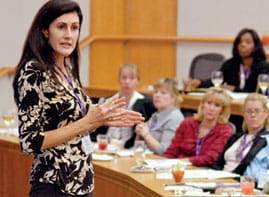Veteran Merrill Lynch executive Jerome Kenney ’67 offers real-world view of finance during guest lecture
4/10/2008 - A senior leader who has spent nearly four decades working in finance treated Kellogg School students to a comprehensive review of the asset management landscape during an April 7 visit to Kellogg.
Jerome Kenney ’67, vice chairman emeritus of Merrill Lynch, provided a thorough, data-driven look at some of the elements influencing investment decisions in today’s volatile market. He spoke to students in Professor Robert Korajczyk’s
Asset Management Practicum.
Kenney, a Kellogg graduate and Northwestern University trustee, called his industry “dynamic and rewarding” and told the class that economic circumstances today make asset management one of the best, fastest-growing careers.
“Asset management is a critical and global field,” Kenney said, pointing out that some $48 trillion in assets worldwide were under management in 2006, with the largest single percentage (about $26 trillion) located in the United States, followed by Europe and Asia. Over the next few years, however, Kenney said the trend is for non-U.S. assets under management (AUM) to grow faster and overtake the U.S. figures. Four of the top five largest asset management firms are located in Europe, Kenney indicated, although half of the top 10 firms are based in the United States. This global trend is likely to continue he said, as the rest of the world continues to “open up faster.”
Kenney also noted various other factors affecting the industry. Among these are demographic numbers showing that high-net-worth individuals and retirees are the two largest and quickest-growing wealth segments. Changes in demographics and wealth cohorts, he said, will have a significant impact on product preferences. Kenney presented data to illustrate how some $9 trillion AUM belongs to retirees, a figure forecasted to balloon to $20 trillion by 2012.
Additional elements impacting the asset management profession, Kenney said, include more sophisticated software and technology and a broader portfolio of investment instruments. While mutual funds and retirement accounts continue to comprise the largest portion of management assets in the United States, newer categories, such as hedge funds, private equity, exchange traded funds (ETF) and indexes are seeing high growth. In particular, Kenney said that indexes and ETFs were “dramatically changing the field in the U.S.” with the rest of the world following quickly.
Kenney said this diversity of asset classes, along with other global economic trends, make asset management an attractive career choice, even for those looking to start a small firm. With most banks, except the biggest, out of the asset management business, Kenney said that independent advisers and boutique brokers were becoming much more prominent. “Products and distribution are changing, and now so is the kind of firm,” he said.
He also indicated that regulatory trends, while subject to change based upon political developments, had long favored the wealth management industry, including through vehicles such as individual retirement accounts, 529 educational funds, annuities, and low capital gains and dividend tax rates. While the cost of complying with regulation, such as Sarbanes-Oxley, is increasing, it is “not restraining good companies from generating attractive growth and returns.”
Professor
Korajczyk, who invited Kenney to speak to the
Asset Management Practicum, called him "the perfect person to discuss the dynamics and future trends in the industry." Because the course is designed to offer an experiential learning opportunity — students manage a $3 million portion of the Kellogg School's endowment —- guest lecturers bring real-world experience into the class and contribute to a vigorous exchange of ideas that embraces theory and practice, Korajczyk said. He and Linda Vincent, associate professor in accounting information and management, co-teach the practicum.
Kenney, a member of the Kellogg Dean’s Advisory Council who has philanthropically supported the
Asset Management Practicum, is today vice chairman emeritus and senior adviser at Merrill Lynch. He began his career as a research analyst in New York at White, Weld and Co., where he soon found himself overseeing the entire research division for the firm. In 1978, White, Weld and Co. merged with Merrill Lynch, where Kenney would become president and CEO of Merrill’s capital markets group in 1984. From 1990 until 2002, Kenney served as head of corporate strategy and research, before assuming the role of vice chairman, a position he held until January.






